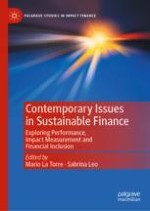2023 | OriginalPaper | Chapter
3. Impact Investments Measurement: Bridging Research and Practice
Authors : Eugenia Strano, Alessandro Rizzello, Annarita Trotta
Published in: Contemporary Issues in Sustainable Finance
Publisher: Springer International Publishing
Activate our intelligent search to find suitable subject content or patents.
Select sections of text to find matching patents with Artificial Intelligence. powered by
Select sections of text to find additional relevant content using AI-assisted search. powered by
